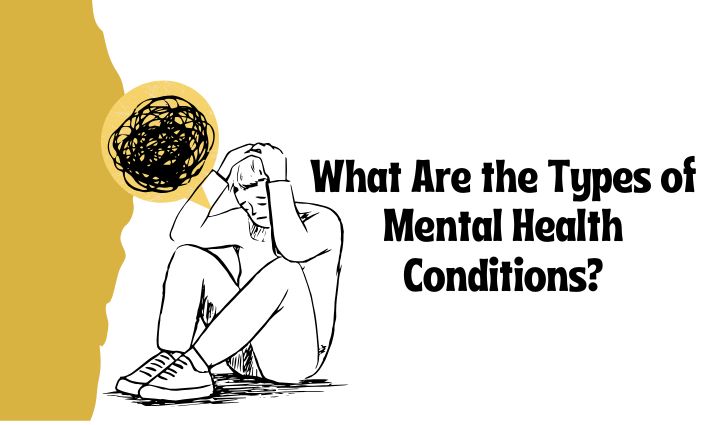
What Are the Types of Mental Health Conditions? Guide to Emotional Wellness
- January 4, 2025
- 0 Likes
- 6094 Views
- 0 Comments
What Are Mental Health Conditions?
Mental health conditions, also called mental illnesses or disorders, are disruptions in emotional, psychological, or social well-being. They affect how individuals think, behave, and interact with others. These conditions range from mild and temporary to severe and chronic, impacting individuals differently.
Common Types of Mental Health Conditions
Below is an overview of the most common types of mental health conditions. Each section highlights their characteristics and aims to demystify these challenges, inspiring hope and understanding.
1. Anxiety Disorders
Anxiety disorders involve excessive fear, worry, or nervousness that interferes with daily life. They include conditions such as:
- Generalized Anxiety Disorder (GAD): Persistent and excessive worry about various aspects of life.
- Panic Disorder: Recurrent panic attacks characterized by sudden, intense fear and physical symptoms like a racing heart or shortness of breath.
- Social Anxiety Disorder: Extreme fear of social situations or being judged by others.
- Phobias: Intense fear of specific objects, places, or situations.
Positive Outlook: Anxiety disorders are highly treatable, often through therapy, medication, or mindfulness techniques.
2. Mood Disorders
Mood disorders, also called affective disorders, involve disturbances in mood, affecting emotional states. They include:
- Major Depressive Disorder (MDD): Prolonged feelings of sadness, hopelessness, or loss of interest in activities.
- Bipolar Disorder: Characterized by mood swings ranging from manic (high energy) to depressive (low energy) episodes.
- Seasonal Affective Disorder (SAD): Depression linked to seasonal changes, often during winter.
Positive Outlook: Early intervention with therapy or lifestyle changes can significantly improve symptoms.
3. Obsessive-Compulsive and Related Disorders
These disorders involve repetitive thoughts or behaviors, including:
- Obsessive-Compulsive Disorder (OCD): Recurring, intrusive thoughts (obsessions) leading to repetitive behaviors (compulsions).
- Body Dysmorphic Disorder (BDD): Preoccupation with perceived flaws in appearance.
- Hoarding Disorder: Difficulty discarding possessions, leading to clutter.
Positive Outlook: Cognitive-behavioral therapy (CBT) and support networks can be life-changing.
4. Trauma- and Stressor-Related Disorders
These conditions develop after experiencing or witnessing traumatic events, such as:
- Post-Traumatic Stress Disorder (PTSD): Persistent distress following trauma, with symptoms like flashbacks, nightmares, or avoidance.
- Acute Stress Disorder (ASD): Short-term symptoms of trauma occurring soon after the event.
- Adjustment Disorders: Emotional or behavioral symptoms following major life changes.
Positive Outlook: Healing is possible with trauma-informed care and community support.
5. Eating Disorders
Eating disorders involve unhealthy relationships with food, weight, or body image, including:
- Anorexia Nervosa: Restriction of food intake, leading to extreme weight loss.
- Bulimia Nervosa: Episodes of binge eating followed by purging.
- Binge Eating Disorder: Repeated episodes of consuming large quantities of food without purging.
Positive Outlook: Recovery often involves a multidisciplinary approach, including medical care, therapy, and nutrition support.
6. Neurodevelopmental Disorders
These conditions typically appear during childhood and affect development. Examples include:
- Attention-Deficit/Hyperactivity Disorder (ADHD): Challenges with focus, hyperactivity, and impulsivity.
- Autism Spectrum Disorder (ASD): A spectrum of conditions affecting communication, behavior, and social interactions.
- Learning Disabilities: Difficulties with specific academic skills like reading or math.
Positive Outlook: Early diagnosis and tailored interventions can help individuals thrive.
7. Psychotic Disorders
Psychotic disorders affect perception, leading to disconnection from reality. They include:
- Schizophrenia: Characterized by hallucinations, delusions, and disorganized thinking.
- Schizoaffective Disorder: A combination of schizophrenia symptoms and mood disorder features.
Positive Outlook: Advances in medication and therapy allow many to manage symptoms effectively.
8. Personality Disorders
Personality disorders involve enduring patterns of behavior and thinking that cause difficulties in relationships and work. Examples include:
- Borderline Personality Disorder (BPD): Intense emotions, fear of abandonment, and unstable relationships.
- Antisocial Personality Disorder: Disregard for others’ rights and societal norms.
- Narcissistic Personality Disorder: Patterns of grandiosity, need for admiration, and lack of empathy.
Positive Outlook: With specialized therapy, individuals can build healthier relationships and coping skills.
9. Substance Use Disorders
Substance use disorders involve the misuse of alcohol, drugs, or other substances, leading to dependence and adverse effects.
- Alcohol Use Disorder: Problematic drinking patterns causing physical, emotional, or social harm.
- Drug Addiction: Compulsive use of substances like opioids, stimulants, or cannabis.
Positive Outlook: Rehabilitation programs and peer support are powerful pathways to recovery.
10. Somatic Symptom and Related Disorders
These conditions involve physical symptoms without a medical cause, such as:
- Somatic Symptom Disorder: Excessive focus on physical symptoms, causing distress.
- Conversion Disorder: Neurological symptoms without an identifiable medical explanation.
Positive Outlook: Psychological therapy can help individuals manage symptoms and improve quality of life.
How to Seek Help for Mental Health Conditions
If you or someone you know is experiencing mental health challenges, seeking help is a brave and empowering step. Here are ways to start:
Use Crisis Resources and Mental Health Services:
If you’re in immediate distress or need support, don’t hesitate to reach out to professional services. Umeed is a trusted platform offering compassionate care to support your mental well-being.
Mental Health Assessment Tests: Umeed provides professional assessments to help you understand your mental health and take actionable steps toward wellness.
Contact Umeed:
Phone: 0343 6004992
24/7 Email Support: [email protected]
Website: www.umeed.com.pk
Taking the first step to seek help is an act of courage. Remember, support is available, and you are not alone on this journey. Reach out today to start building a brighter, healthier future.
FAQs About Mental Health Conditions
Q: How common are mental health conditions?
A: Mental health conditions are widespread, with 1 in 5 adults experiencing a mental illness in any given year.
Q: Can mental health conditions be cured?
A: While some conditions may not have a cure, many can be effectively managed with treatment, allowing individuals to lead fulfilling lives.
Q: Are mental health conditions genetic?
A: Genetics can play a role, but environmental factors, life experiences, and personal resilience also significantly influence mental health.
Q: How can I support someone with a mental health condition?
A: Listen without judgment, encourage professional help, and educate yourself about their condition.
Final Thoughts
Mental health conditions are part of the human experience, and understanding them is the first step toward acceptance and recovery. By breaking down barriers and fostering compassion, we can create a world where seeking help is seen as a strength.
Let’s commit to mental health awareness, celebrate progress, and support each other on the journey to emotional wellness. Together, we can make a difference!
